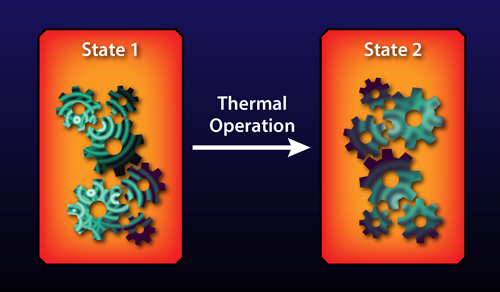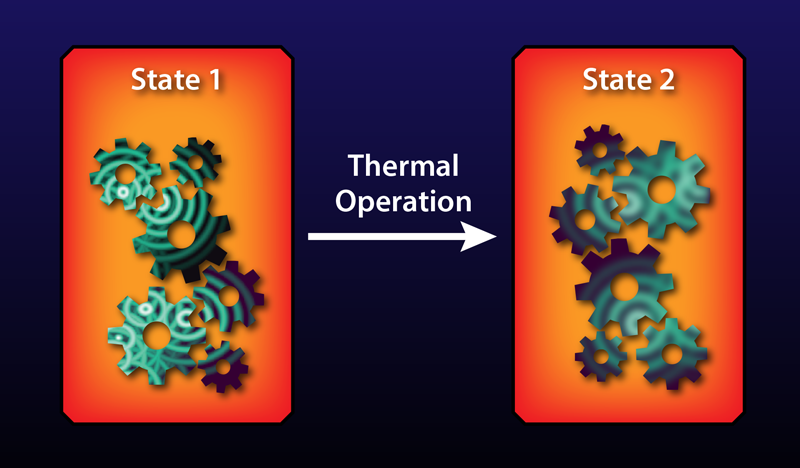New Entry in the Thermodynamic Rulebook for Quantum Systems
Physicists are developing new experimental tools to build engines, refrigerators, and other thermodynamic machines with quantum components. Such machines are not only small, but they might also possess unexpected capabilities compared to their classical counterparts. Finding the fundamental limits on how these machines operate—a set of thermodynamic laws that apply on the quantum scale—is therefore an important theoretical goal. In independent papers, Piotr Ćwikliński from the University of Gdansk, Poland [1], and colleagues, and Matteo Lostaglio at Imperial College, UK, and colleagues [2] have derived a set of such laws, akin to the second law, for quantum systems that exist in a coherent superposition of states. These laws spell out the restrictions for how such a system can evolve under any physically plausible operation, thus providing ultimate limitations that even quantum machines cannot overcome.
Theoretical thermodynamics has always been practically motivated. Its aim is to develop principles that tell us what types of machines we can build, and the limits on their efficiency and output. Our ability to manipulate a system depends on the information we have about its state. Recent efforts to understand the thermodynamics of quantum systems have therefore been inspired by quantum information theory [3], a field perhaps best known in connection with quantum cryptography and computing.
In this context, thermodynamic descriptions involve very little information. Thermodynamic theory of classical systems assumes we can’t know the microstates of each constituent in a large collection of particles, but only some average quantities, like a system’s total internal energy. When such a system is in thermal equilibrium with its environment, we can, however, describe it in terms of a single parameter: the temperature. Since entropy quantifies a lack of information, this reductive description corresponds to the one with the greatest possible entropy still compatible with a specified internal energy. A system described by such thermal states is therefore said to serve as a “ubiquitous” resource for machines, because no assumption is made about its internal workings. And any operation that requires more knowledge of the system—say, knowing the positions of each atom in a gas—is impossible.
Thermalization is also an important notion in the quantum regime [4], and machines operating at such scales can also take advantage of thermal resources. The thermal-resource-theory approach to quantum thermodynamics aims to identify which operations are feasible and which ones are impossible. In this framework, thermal operations define all actions a quantum system can perform, with the restriction that the total energy of the machine and its thermal environment must be conserved—the dictum of the first law of thermodynamics. The set of all such operations thus functions as a sort of “rule book” for physical processes.
The resource-theory approach has been used for classical systems to derive the second law of thermodynamics from microscopic principles. Unlike classical systems, however, quantum systems have the added complexity that they have discretized energy levels and can exist in coherent superpositions of different states. So far, the resource-theory approach has been used to find a whole family of second-law-like restrictions for quantum systems [5], but these restrictions haven’t applied to coherent quantum states.
The research by Ćwikliński et al. [1] and Lostaglio et al. [2] extends these restrictions to also account for a system in a coherent quantum superposition of states. In so doing, they have introduced a genuine second law of thermodynamics for quantum systems. Both groups study the possible transformations of coherent states between distinct energy levels under thermal operations (Fig. 1). Their analysis directly utilizes density matrices, which represent the quantum state of a system. Specifically, the diagonal entries of the matrix give the probability of finding a system in one of its allowed energies, while each off-diagonal element quantifies the coherence of two energy levels involved in a superposition—that is, the potential of these two levels to exhibit wave-like interference.
The groups show that the thermodynamic processes that a system in a coherent superposition of states can undergo are fundamentally limited. Their approaches to finding these limitations were, however, somewhat different. Ćwikliński et al. got their results by investigating transformations between different matrix elements. Lostaglio et al. instead used a mode decomposition of the density matrices [6], an analysis that allowed them to refine the laws using fundamental symmetries of nature.
The laws of thermodynamics for incoherent states require that entropy grow under any permissible operation [5]. The new results from both groups show that other conditions apply when quantum coherence is involved. For example, the researchers find that coherence tends to be lost in operations that involve shifting the mixture of states in a quantum superposition. Lostaglio and some of his coauthors made this point in a separate paper [7]. But the new papers provide a more quantitative understanding of the second-law-like restrictions that can never be overcome. Their results also imply that, in certain transformations, coherence can be viewed as a resource—a bit like a “coherence battery”— to overcome these limitations.
The analyses by these two groups advance our knowledge of the fundamental constraints of using coherence in thermodynamic settings. But the quest for understanding the possibilities and limitations of operating machines at the quantum scale is far from over. The authors acknowledge that the resulting laws are still incomplete, and that there must be yet unknown stricter constraints on achievable transformations. Still, we know that coherence and other quantum effects provide us with an extended range of potential transformations whose effects may exceed the limitations of classical thermodynamics. For example, theoretical work has shown that coherence could be used as a catalyst [8], and that it can improve the power of quantum engines [9]. In addition, more work can, in theory, be extracted from correlated particles if they are in a coherent quantum superposition than if they are in a classical state [10] (see 22 October 2015 Synopsis).
This research is published in Physical Review Letters and Physical Review X.
References
- “Limitations on the Evolution of Quantum Coherences: Towards Fully Quantum Second Laws of Thermodynamics,” Phys. Rev. Lett. 115, 210403 (2015).
- M. Lostaglio, K. Korzekwa, D. Jennings, and Terry Rudolph, “Quantum Coherence, Time-Translation Symmetry, and Thermodynamics,” Phys. Rev. X 5, 021001 (2015).
- J. Goold, M. Huber, A. Riera, L. del Rio, and P. Skrzypczyk, “The Role of Quantum Information in Thermodynamics—A Topical Review,” arXiv:1505.07835.
- J. Eisert, M. Friesdorf, and C. Gogolin, “Quantum Many-Body Systems Out of Equilibrium,” Nature Phys. 11, 124 (2015).
- F. Brandão, M. Horodecki, N. Ng, J. Oppenheim, and S. Wehner, “The Second Laws of Quantum Thermodynamics,” Proc. Natl. Acad. Sci. U.S.A. 112, 3275 (2015).
- I. Marvian and R. W Spekkens, “Extending Noether’s Theorem by Quantifying the Asymmetry of Quantum States,” Nat. Commun. 5, 3821 (2014).
- M. Lostaglio, D. Jennings, and T. Rudolph, “Description of Quantum Coherence in Thermodynamic Processes Requires Constraints Beyond Free Energy,” Nat. Commun. 6, 6383 (2015).
- Johan Åberg, “Catalytic Coherence,” Phys. Rev. Lett. 113, , 150402 (2014).
- R. Uzdin, A. Levy, and R. Kosloff, “Equivalence of Quantum Heat Machines, and Quantum-Thermodynamic Signatures,” Phys. Rev. X 5, 031044 (2015).
- M. Perarnau-Llobet, K. V. Hovhannisyan, M. Huber, P. Skrzypczyk, N. Brunner, and A. Acín, “Extractable Work from Correlations,” Phys. Rev. X 5, 041011 (2015).





